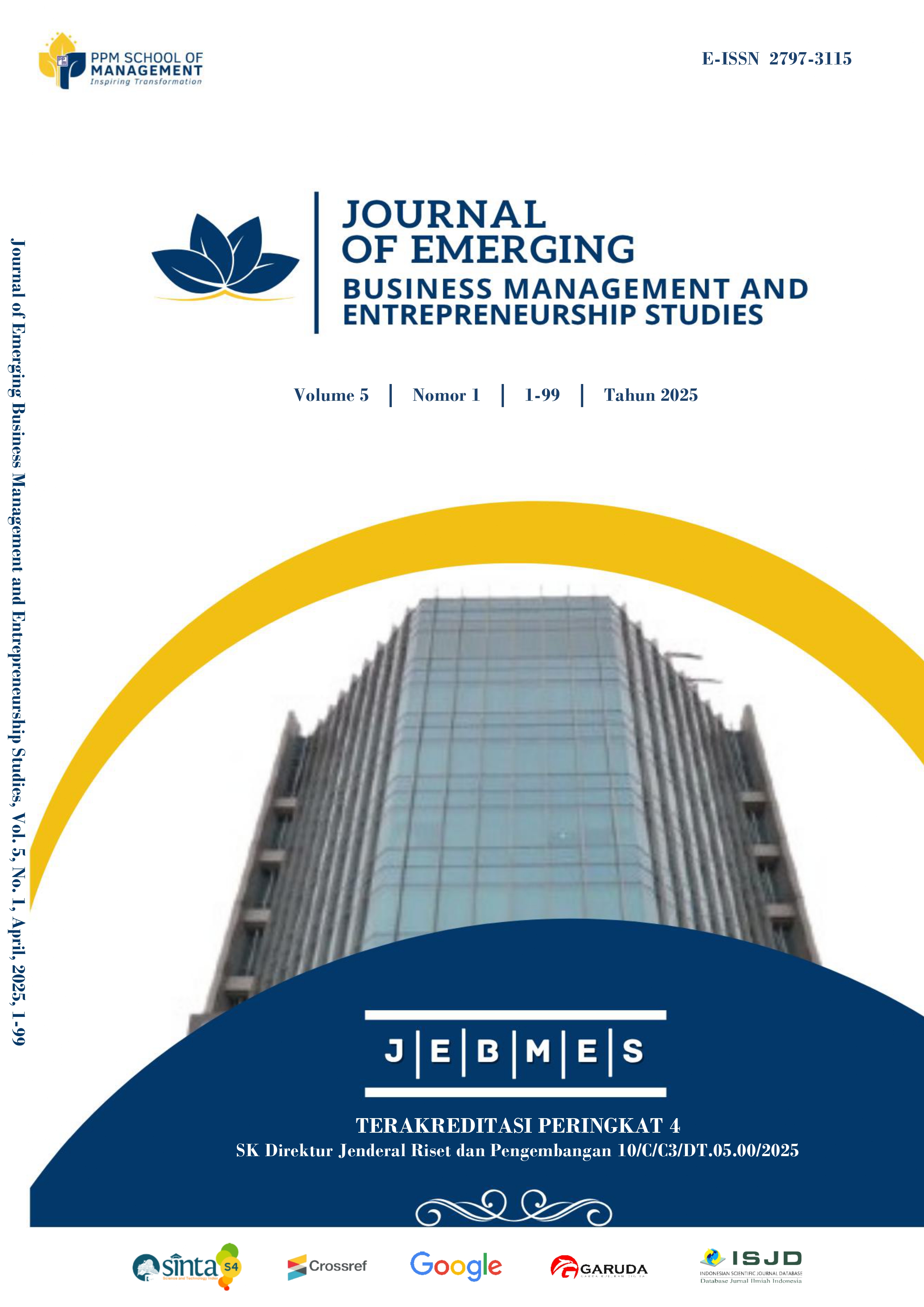How to be ‘Green’ in Apparel Supply Chain? Proposed Model of Green Motives and Practices Relation: A Systematic Literature Review
DOI:
https://doi.org/10.34149/jebmes.v5i1.181Keywords:
Apparel, fashion, green motives, green practices, supply chain, sustainabilityAbstract
The growth of the apparel industry has led to an increase in waste that is disruptive to the environment, while green behavior in its supply chain still needs to be improved. This study aims to investigate the apparel supply chain’s green motives and green programs and propose a relevant model based on the result. The systematic literature review was carried out in three stages based on the PRISMA Protocol. The study obtained 409 articles from the Scopus database, and after conducting the filtering stages, 35 articles were yielded and analyzed concerning the research questions. Results showed that the green motives of the apparel supply chain are the stakeholders’ intention and requirements, government support, instability, ethical issues, collaboration partners’ requirements, environmental responsibility of the organizations, and leader commitment. Green practices in the apparel supply chain are decentralizing operations for reverse logistics, promoting circularity in business processes, eco-friendly product development, digitalization along the supply chain, green technology adoption, green advertising, green certification, green collaboration initiatives, and customer education programs. A proposed model of green motives and practices relation was developed to guide government and policymakers in formulating green strategies to promote green practices in the apparel industry.
References
Abbate, S., Centobelli, P. & Cerchione, R. (2023). From fast to slow: An exploratory analysis of circular business models in the Italian Apparel Industry. International Journal of Production Economics, 260, 108824. https://doi.org/10.1016/j.ijpe.2023.108824.
Abdelmeguid, A., Afy-Shararah, M. & Salonitis, K. (2024). Towards circular fashion: Management strategies promoting circular behaviour along the value chain. Sustainable Production and Consumption, 48, 143-156. https://doi.org/10.1016/j.spc.2024.05.010
Adhikari, A. & Bisi, A. (2020). Collaboration, bargaining, and fairness concern for a green apparel supply chain: An emerging economy perspective. Transportation Research Part E: Logistics and Transportation Review, 135, 1011863. https://doi.org/10.1016/j.tre.2020.101863
Alves, W., Sila, A. & Rodrigues, H.S. (2020). Green practices as a path towards the sustainability: Evidence from Portuguese Companies. Business System Research, 11(2), 7-20. DOI: 10.2478/bsrj-2020-0012.
Ba Awain, A.M., Al-Ansi, A.M. & Jaboob, M. (2023). Green supply chain management: A comprehensive review of research, application and future directions. Management and Production Engineering Review, 3, 118-133. DOI: 10.24425/mper.2023.147194.
Baker, K. & McNeill, L.S. (2024). A five-stage framework for sustainability certification for fashion brands: Can a standardized approach work in the fashion industry? International Journal of Fashion Design, Technology and Education, 17(3), 287-301. https://doi.org/10.1080/17543266.2023.2277263
Bhandari, N., Garza-Reyes, J.A., Rocha-Lona, L., Kumar, A., Naz, F. & Joshi, R. (2022). Barriers to sustainable sourcing in the apparel and fashion luxury industry. Sustainable Production and Consumption, 31, 220-235. https://doi.org/10.1016/j.spc.2022.02.007.
Chen, L., Yu, H. & Yan, X. (2018). Developing a modular apparel safety architecture for supply chain management: the apparel recycle perspective. Industria Textila, 69(1). Doi:10.35530/IT.069.01.1380.
Chowdhury, N.A., Ali, S.M., Paul, S.K., Mahtab, Z. & Kabir, G. (2020). A hierarchical model for critical success factors in apparel supply chain. Business Process Management Journal, 26(7), 1761-1788. https://doi.org/10.1108/BPMJ-08-2019-0323.
Ciasullo, M.V., Cardinali, S. & Cosimato, S. (2018). Exploring sustainable behaviour in international footwear supply chain management. International Journal of Business and Globalisation, 20(3), 416-436.
Da Giau, A., Macchion, L., Caniato, F., Caridi, M., Danese, P., Rinaldi, R. & Vinelli, A. (2016). Sustainability practices and web-based communication: An analysis of the Italian fashion industry. Journal of Fashion Marketing and Management, 20(1), 72-88. https://doi.org/10.1108/JFMM-07-2015-0061
Dragomir, V.D. & Dumitru, M. (2022). Practical solutions for circular business models in the fashion industry. Cleaner Logistics and Supply Chain, 4, 100040. https://doi.org/10.1016/j.clscn.2022.100040.
Elkington, J. (1998). Cannibals with forks: The triple bottom line of 21. Century Business, Gabriola Island, BC Canada: New Society Publishers.
Fani, V., Bucci, I., Bandinelli, R. & da Silva, E.R. (2025). Sustainable reverse logistics network design using simulation: Insights from fashion industry. Cleaner Logistics and Supply Chain, 14, 100201. https://doi.org/10.1016/j.clscn.2024.100201.
Farzin, M., Shababi, H., Sasi, G.S., Sadeghi, M. & Makvandi, R. (2023). The determinants of eco-fashion purchase intention and willingness to pay. Spanish Journal of Marketing – ESIC, 27(3). DOI 10.1108/SJME-07-2022-0158.
Grand View Research. (2024). Textile Market Size, Share & Trends Analysis Report. Accessed in https://www.grandviewresearch.com/industry-analysis/textile-market#:~:text=The%20global%20textile%20market%20size%20was%20estimated%20at%20USD%201%2C837.27,USD%203%2C047.23%20billion%20by%202030.
Gunasekaran, A., Patel, C. & McGaughey, R.E. (2004). A framework for supply chain performance measurement. International Journal of Production Economics, 87(3), 333-47. DOI 10.1108/14635770510609015.
Gupta, V., Arora, M. & Minhas, J. (2020). Innovating opportunities for fashion brands by using textile waste for better fashion. Recycling from Waste in Fashion and Textiles, https://doi.org/10.1002/9781119620532.ch5.
Hsu, C-H., Chang, A-Y., Zhang, T-Y., Lin, W-D. & Liu, W-L. (2021). Deploying resilience enablers to mitigate risks in sustainable fashion supply chains. Sustainability, 13(5), 2943. https://doi.org/10.3390/su13052943
Jadhav, S. & Verma, A. (2024). Environmental awareness toward issues and challenges of sustainable consumerism on the Indian Apparel Industry. Nature Environment and Pollution Technology, 23(4), 2231-2239. https://doi.org/10.46488/NEPT.2024.v23i04.027.
Javed, T., Mahmoud, A.B., Yang, J., Zhao, X. (2024). Green branding in fast fashion: examining the impact of social sustainability claims on Chinese consumer behaviour and brand perception. Corporate Communications: An International Journal, 29(6), 915-934. https://doi.org/10.1108/CCIJ-12-2023-0169
Karaosman, H., Perry, P., Brun, A. & Morales-Alonso, G. (2020). Behind the runway: Extending sustainability in luxury fashion supply chains. Journal of Business Research, 117, 652-663. https://doi.org/10.1016/j.jbusres.2018.09.017
Khairul Akter, M.M., Haq, U.N., Islam, M.M. & Uddin, M.A. (2022). Textile-apparel manufacturing and material waste management in the circular economy: A conceptual model to achieve sustainable development goal (SDG) 12 for Bangladesh. Cleaner Environmental Systems, 4(100070). Doi: 10.1016/j.cesys.2022.100070.
Küçük, M., Weber, M.O., Bühs, C. & Muschkiet, M. (2021). A comparative analysis of green logistic activities in German and Turkish textile enterprises. Industria Textila, 72(01), 11-18. DOI: 10.35530/IT.072.01.1681.
La Rosa, A. & Jorgensen, J.J. (2021). Influences on consumer engagement with sustainability and the purchase intention of apparel products. Sustainability, 13(19), 10655. https://doi.org/10.3390/su131910655.
Landi, F.F.D., Fabiani, C., Ploppi, B. & Pisello, A. L. (2023). Sustainable management in the slow fashion industry: carbon footprint of an Italian brand. The International Journal of Life Cycle Assessment, 28, 1229-1247. https://doi.org/10.1007/s11367-023-02205-6.
Lin, P. & Chen, W. (2022). Factors that influence consumer’s sustainable apparel purchase intention: The moderating effect of generational cohorts. Sustainability, 14, 8950. https://doi.org/10.3390/su14148950.
Ma, J., Huang, L., Guo, Q. & Zhu, Y. (2024). Sustainability in design: Sustainable fashion design practices and environmental impact using mixed-method analysis. Business Strategy and the Environment, 33(7), 6889-6910. https://doi.org/10.1002/bse.3843
Milewska, B. (2022). The impact of instability in the business environment on the competitiveness of enterprises using the example of the apparel industry. Sustainability, 14(22), 14673. https://doi.org/10.3390/su142214673
Niinimaki, K., Peters, G., Dahlbo, H., Perry, P., Rissanen, T. & Gwilt, A. (2020). The environmental price of fast fashion. Nature Reviews Earth & Environment, 1, 189-200. https://doi.org/10.1038/s43017-020-0039-9.
Penz, E. & Drewes, K.L. (2022). What shapes pro-environmental attitudes and intention for sustainable fashion consumption during a stressful time event? Sustainability, 14(22), 15331. https://doi.org/10.3390/su142215331
Perry, P., Osburg, V.S., Huq, F.A. & Diallo, M.F. (2025). Fashionable ethics: Exploring ethical perspectives in the production, marketing, and consumption of fashion. Journal of Business Ethics, 196, 711-721. https://doi.org/10.1007/s10551-024-05913-7.
Rafi-Ul-Shan, P., Grant, D.B. & Perry, P. (2022). Are fashion supply chains capable of coopetition? An exploratory study in the UK. International Journal of Logistics Research and Applications, 25(3), 278-295. https://doi.org/10.1080/13675567.2020.1784118.
Sandberg, E. (2023). Orchestration capabilities in circular supply chains of post-consumer used clothes- A case study of a Swedish fashion retailer. Journal of Cleaner Production, 387, 135935. https://doi.org/10.1016/j.jclepro.2023.135935
Shen, B., Zhu, C., Li, Q. & Wang, X. (2021). Green technology adoption in textiles and apparel supply chains with environmental taxes. International Journal of Production Research, 59(14), 4157-4174. https://doi.org/10.1080/00207543.2020.1758354
Talay, C., Oxborrow, L. & Brindley, C. (2020). How small suppliers deal with the buyer power in asymmetric relationships within the sustainable fashion supply chain. Journal of Business Research, 117, 604-614. https://doi.org/10.1016/j.jbusres.2018.08.034
Textile and apparel sustainability updates, 2020. Textiles Intelligence.
Tolentino-Zondervan, F. & DiVito, L. (2024). Sustainability performance of Dutch firms and the role of digitalization: The case of textile and apparel industry. Journal of Cleaner Production, 459, 142573. https://doi.org/10.1016/j.jclepro.2024.142573.
Warasthe, R., Schulz, F., Enneking, R. & Brandenburg, M. (2020). Sustainability prerequisites and practices in textile and apparel supply chains. Sustainability, 12, 9960. Doi:10.3390/su12239960.
Wiedemann, S.G., Biggs, L., Nebel, B., Bauch, K., Laitala, K., Klepp, I.G., Swan, P.G. & Watson K. (2020). Environmental impacts associated with the production, use, and end-of-life of a woollen garment. International Journal of Life Cycle Assessment, 25(8), 1486-1499. Doi: 10.1007/s11367-020-01766-0.
Wren, B, (2022). Sustainable supply chain management in the fast fashion Industry: A comparative study of current efforts and best practices to address the climate crisis. Cleaner Logistics and Supply Chain, 4, 100032. https://doi.org/10.1016/j.clscn.2022.100032.
Yadlapalli, A., Rahman, S. & Gunasekaran A. (2018). Socially responsible governance mechanisms for manufacturing firms in apparel supply chains. International Journal of Production Economics, 196, 135-149. https://doi.org/10.1016/j.ijpe.2017.11.016
Zamani, B., Sandin, G. & Peters, G.M. (2017). Life cycle assessment of clothing libraries: can collaborative consumption reduce the environmental impact of fast fashion? Journal of Cleaner Production, 162, 1368–1375. doi:10.1016/j.jclepro.2017.06.128
Zhang, L., Zhang, Y. & Chutani, A. (2022). Riding the wave of fashion rental: The role of power structures and green advertising. Transportation Research Part E: Logistics and Transportation Review, 168, 102946. https://doi.org/10.1016/j.tre.2022.102946.
Downloads
Published
Issue
Section
License
Copyright (c) 2025 Journal of Emerging Business Management and Entrepreneurship Studies

This work is licensed under a Creative Commons Attribution 4.0 International License.
License and Copyright Agreement
In submitting the manuscript to the journal, the authors certify that:
- They are authorized by their co-authors to enter into these arrangements.
- The work described has not been formally published before, except in the form of an abstract or as part of a published lecture, review, thesis, or overlay journal.
- That it is not under consideration for publication elsewhere,
- That its publication has been approved by all the author(s) and by the responsible authorities tacitly or explicitly of the institutes where the work has been carried out.
- They secure the right to reproduce any material that has already been published or copyrighted elsewhere.
- They agree to the following license and copyright agreement.





